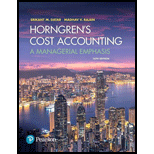
Strategic analysis of operating income (continuation of 12-25). Refer to Exercise 12-25.
- 1. Calculate the operating income of Stanmore Corporation in 2016 and 2017.
- 2. Calculate the growth, price-recovery, and productivity components that explain the change in operating income from 2016 to 2017.
- 3. Comment on your answer in requirement 2. What do these components indicate?
12-25 Strategy, balanced scorecard. Stanmore Corporation makes a special-purpose machine, D4H, used in the textile industry. Stanmore has designed the D4H machine for 2017 to be distinct from its competitors. It has been generally regarded as a superior machine. Stanmore presents the following data for 2016 and 2017.
| 2016 | 2017 | |
| 1. Units of D4H produced and sold | 200 | 210 |
| 2. Selling price | $40,000 | $42,000 |
| 3. Direct materials (kilograms) | 300,000 | 310,000 |
| 4. Direct material cost per kilogram | $8 | $8.50 |
| 5. Manufacturing capacity in units of D4H | 250 | 250 |
| 6. Total conversion costs | $2,000,000 | $2,025,000 |
| 7. Conversion cost per unit of capacity (row 6 ÷ row 5) | $8,000 | $8,100 |
| 8. Selling and customer-service capacity | 100 customers | 95 customers |
| 9. Total selling and customer-service costs | $1,000,000 | $940,500 |
| 10. Selling and customer-service capacity cost per customer (row 9 ÷ row 8) | $10,000 | $9,900 |
Stanmore produces no defective machines, but it wants to reduce direct materials usage per D4H machine in 2017. Conversion costs in each year depend on production capacity defined in terms of D4H units that can be produced, not the actual units produced. Selling and customer-service costs depend on the number of customers that Stanmore can support, not the actual number of customers it serves. Stanmore has 75 customers in 2016 and 80 customers in 2017.
- 1. Is Stanmore’s strategy one of product differentiation or cost leadership? Explain briefly.
- 2. Describe briefly key measures that you would include in Stanmore’s balanced scorecard and the reasons for doing so.
Trending nowThis is a popular solution!

Chapter 12 Solutions
Horngren's Cost Accounting: A Managerial Emphasis (16th Edition)
 Managerial AccountingAccountingISBN:9781337912020Author:Carl Warren, Ph.d. Cma William B. TaylerPublisher:South-Western College Pub
Managerial AccountingAccountingISBN:9781337912020Author:Carl Warren, Ph.d. Cma William B. TaylerPublisher:South-Western College Pub Financial And Managerial AccountingAccountingISBN:9781337902663Author:WARREN, Carl S.Publisher:Cengage Learning,
Financial And Managerial AccountingAccountingISBN:9781337902663Author:WARREN, Carl S.Publisher:Cengage Learning, Survey of Accounting (Accounting I)AccountingISBN:9781305961883Author:Carl WarrenPublisher:Cengage Learning
Survey of Accounting (Accounting I)AccountingISBN:9781305961883Author:Carl WarrenPublisher:Cengage Learning


